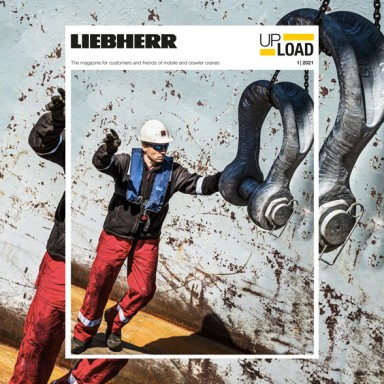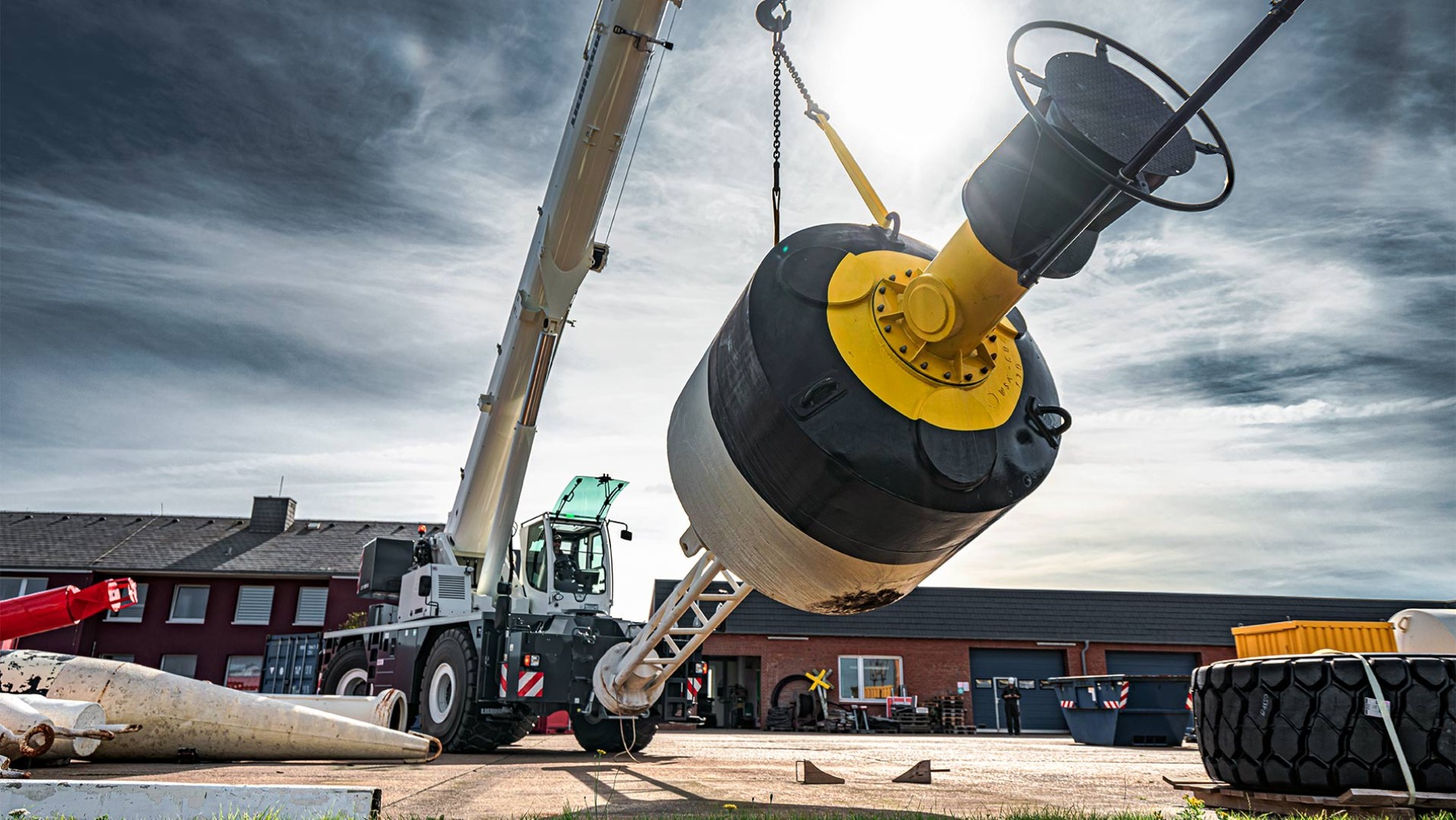
13 minutes | magazine 01/2021
Swabian power for Heligoland
For crane operator Jens Bodschwinna, this story starts with a bit of nostalgia, as he has to say goodbye to his long-time work colleague.
Joyride – a crane trip with a sea crossing
His Liebherr LTL 1050 crane, which started work at the Tönning site of the Waterways and Shipping Office (WSA) on the German North Sea island of Heligoland in 1992, is due to be decommissioned in the near future. After 28 years in the service of the state, the metallic veteran has earned its retirement. The long-winded process of procuring a successor with a tendering process was finally completed when a contract was signed with us in Ehingen. The authority’s choice was the Liebherr LRT 1090-2.1, the rough terrain version of the mobile cranes from our Swabian crane plant. We delivered the new crane to the island in September – on the actual birthday of its future operator, Jens Bodschwinna.
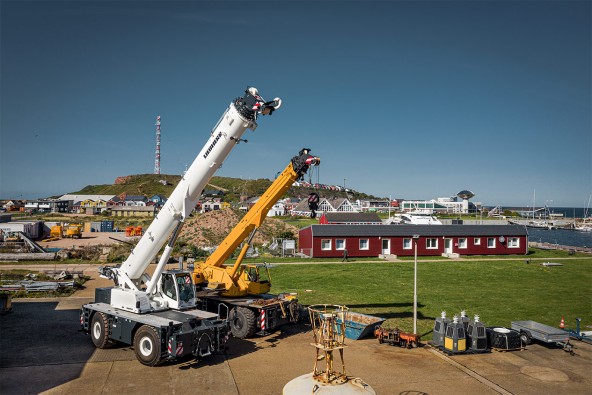
A whole new dimension – the telescopic boom is around 50 percent longer and will enable the crane to be used for work on the island’s lighthouse. The new LRT 1090-2.1 is shown here parked next to its predecessor, the yellow LTL 1050, which has clocked almost thirty years of service.
“I’ve never had a birthday present like it”, beams the bearded Heligolander under his baseball cap. However, his joy is mixed with a degree of sorrow, when he looks at the predecessor of his brand new crane. The old Liebherr crane, whose abbreviation LTL stands for what today sounds like a rather antiquated name, the “Liebherr Telescopic Lowspeed” crane was there when Bodschwinna first started work as a crane operator for the WSA 25 years ago. Today he also acts as foreman and fitter. But let’s get one thing straight from the start – it was not that the old crane was getting old or breaking down more that made the authority buy the new one. In fact, it was obtaining spare parts from suppliers which was proving increasingly difficult for the old machine. “To date we have never had problems with Liebherr’s service” says Mark Redecker, the WSA’s engineer on the North Sea island.
Three years after the procedure for purchasing a new mobile crane started, the LRT 1090-2.1 was finally delivered in the autumn. The rough terrain crane was given a piggyback from Ehingen across Germany to Cuxhaven on a heavy haulage vehicle, where supply vessel “HC Hagemann I” was already waiting for its cargo in the harbour. However, the wind and weather were not so keen on the crane making the crossing on the scheduled day. Winds between five and six on the Beaufort scale were forecast. When the wind gets above four on the Beaufort scale, the boat, which is authorised for sea crossings, stays in the harbour. The waves generated by the wind would simply be too dangerous for the flat-bottomed supply vessel. The next morning, however, it was time to cast off and the HC Hagemann I went to sea before sunrise. Finally, our crane was able to start its 60 kilometre voyage on the North Sea to its new home.
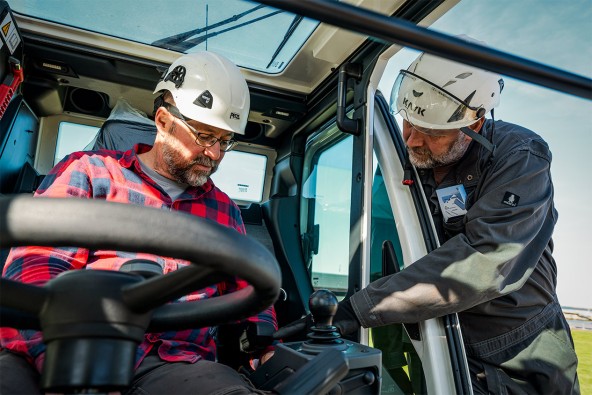
Jens Bodschwinna is familiarised with the features of the control system on his new Liebherr crane by Service Engineer Florian Hagen.
Search for aerial bombs interrupted
Florian Hagen, the broad-shouldered service engineer from Liebherr in Hamburg, also checked in on the service vessel in Cuxhaven very early. He was there for the handover and induction training on the brand new crane. After a voyage lasting around four hours, the supply vessel and its cargo reached Germany’s only deep sea island where Hagen’s first job was to drive the rough terrain crane off the ship. He used the ramp at the bow to drive the vehicle onto a small sandy beach in the island’s southern harbour. The crane and operator had once again reached dry land.
The LRT 1090-2.1 was then immediately able to demonstrate its off-road capability. The first section of the route to the WSA actually passed through the broken surface of the wave-breaking basin where a bomb disposal team had been conducting a search for aerial bombs dating from the Second World War buried several metres deep for months. The bomb disposal team had to stop all its work on the site temporarily whilst the crane made its way through the basin. Half an hour later, the sparkling white crane was then finally parked next to its somewhat smaller predecessor at the Waterways and Shipping Office depot.
I can now carry out precise planning for projects which I would previously not been confident with.
“In addition to the normal induction training for the crane functions, because of its location here on Heligoland, we gave special attention to troubleshooting and the remote diagnostic functions”, explains Florian Hagen. Travelling to the island is always a very expensive trip for a service engineer. So it is a good idea if the crane operator can rectify any problems on his own or using remote diagnostics with the support of the headquarters in Ehingen.
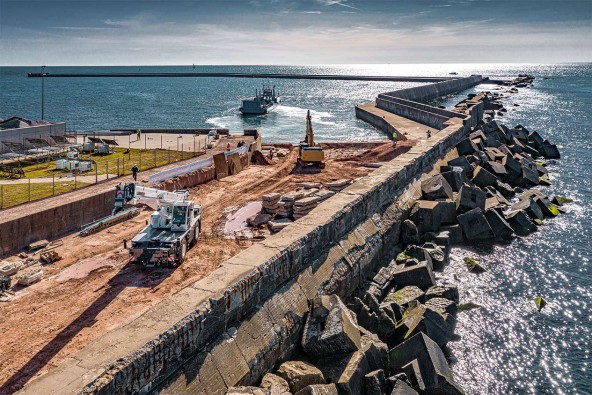
Rolling home – the new rough terrain crane at the Heligoland site of the Waterways and Shipping Office makes its way through the wave-breaking basin. The search for aerial bombs had to be stopped whilst the crane passed through. The “HC Hagemann I” supply vessel can be seen in the background having already cast off on its return journey. The vessel had just transported the LRT 1090-2.1 to Heligoland from Cuxhaven.
Longer boom will enable the crane to work on the lighthouse in the future
Jobs waiting for the new rough terrain crane on Heligoland are, of course, mainly of a maritime nature, although that is not exclusively the case. For example, the 47 metre telescopic boom, which is more than 50 percent longer than its predecessor’s, will also be able to tackle antenna and maintenance work on the island’s 35 metre lighthouse. The crane will also have to hoist a number of boats out of the water before the onset of winter and place them back in the water in spring.
However, its main work will be transporting floating sea marks. “Even our heaviest sea mark, which weighs over eleven tonnes, can be transported on the crane hook. That's why we need a crane in this lifting capacity class”, explains Bodschwinna. “We're responsible for the safety of shipping around Heligoland.” The WSA site owns a total of 56 of these navigation marks. In the future, he and his crane will have to transport these maritime signposts, known as “buoys” in the jargon, between the depot and the jetty.
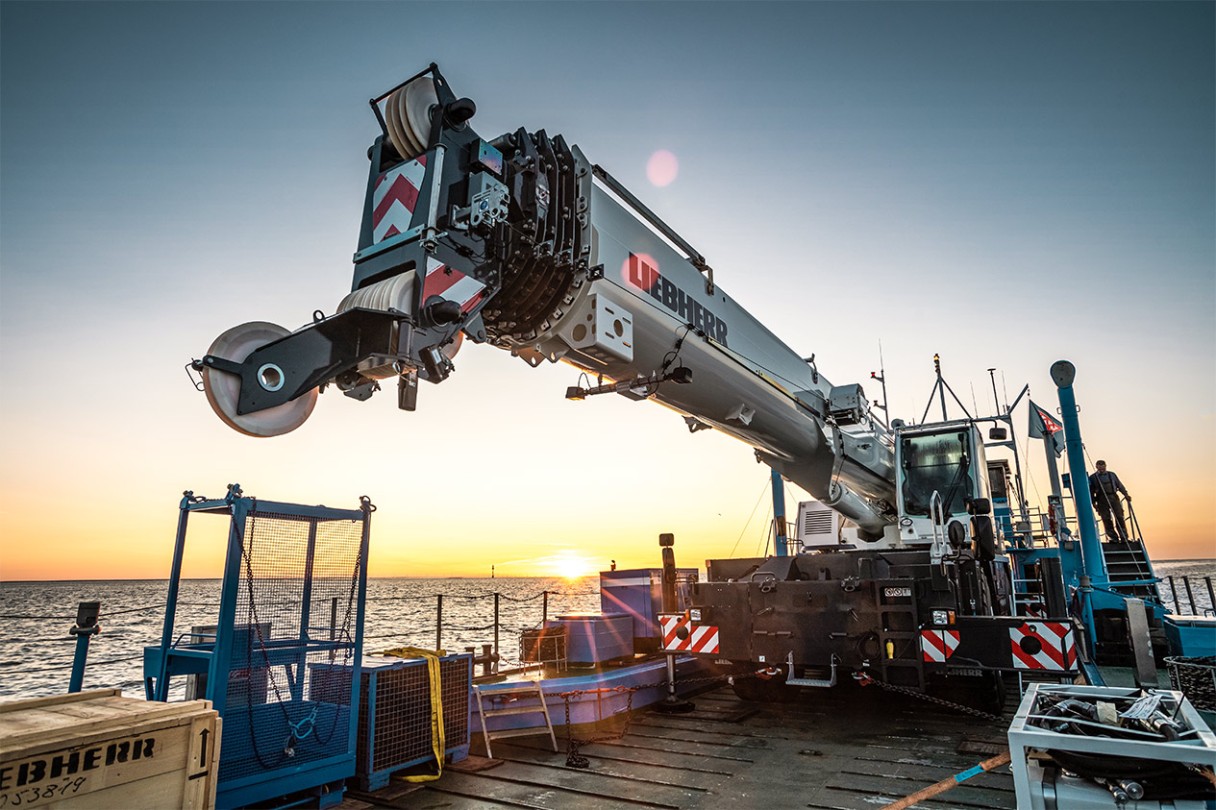
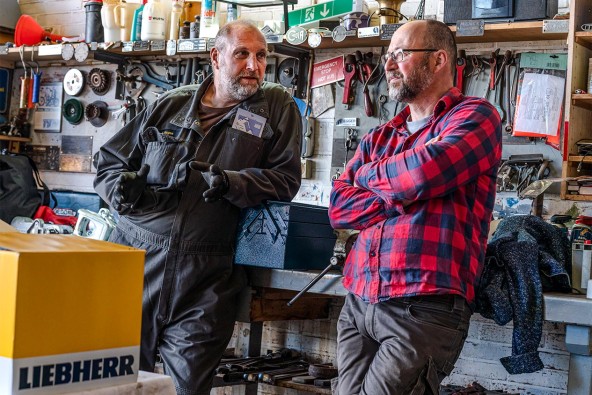
Expert chat – WSA crane operator Jens Bodschwinna (right) and Florian Hagen, the service engineer from Liebherr, talk shop in the depot workshop.
Buoys also warn shipping about wrecks
After they have been in use in the salty water of the North Sea for around three years, the swimming sea marks must be replaced and brought to Heligoland for refurbishment. They are brought to the buoys depot and the WSA workshop, where the heavy floating structures are then cleaned, coated with new preservative and fitted with the appropriate lights. The crane then transports the refurbished buoys to the supply vessels’ pier around 500 metres away where they are placed ready for the vessels to put them back in the water. The freshly painted maritime traffic signs are generally hoisted on board by the vessels themselves so that they can then take them out to sea, up to five kilometres from the island in some cases. They are used to mark shipping routes and warn vessels about wrecks and shallows.
After the first few months using his new machine, experienced crane operator Jens is very positive: “The modern technology on the crane has catapulted us into a whole new era on a technological level. The wide range of data and parameters supplied by the LICCON control system are very helpful and make working with the machine so much easier. I can now carry out precise planning for projects which I would previously not been confident with. That also makes crane operations much safer, of course”, adds Bodschwinna. “Great technology” is his brief, final summary. Then he climbed aboard his brand new Liebherr crane, drove it slowly out of the garage and into the island where their first working day on Heligoland awaited the two of them.
This article was published in the UpLoad magazine 01 | 2021.

